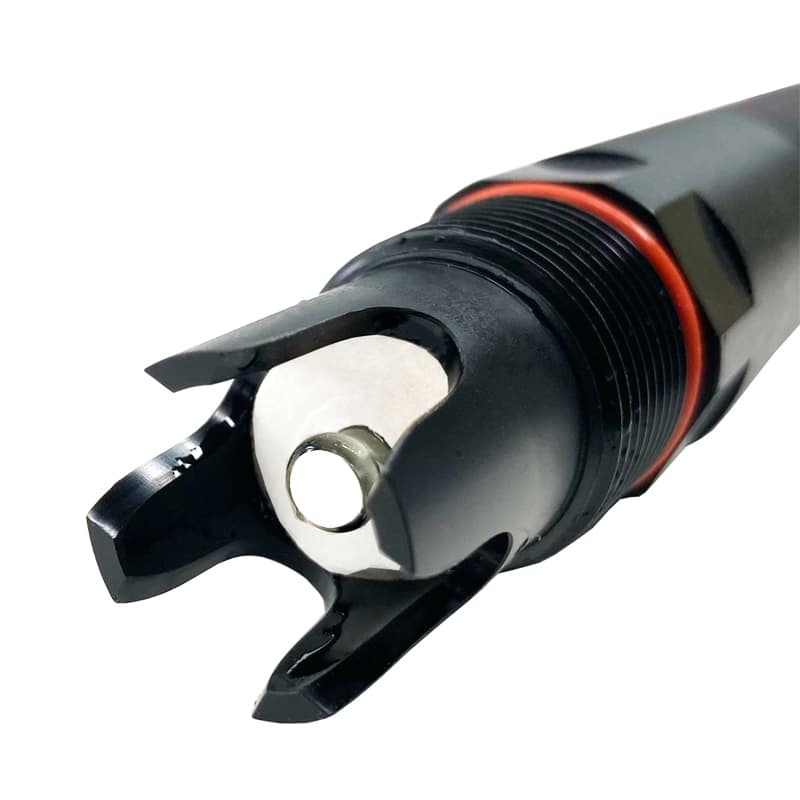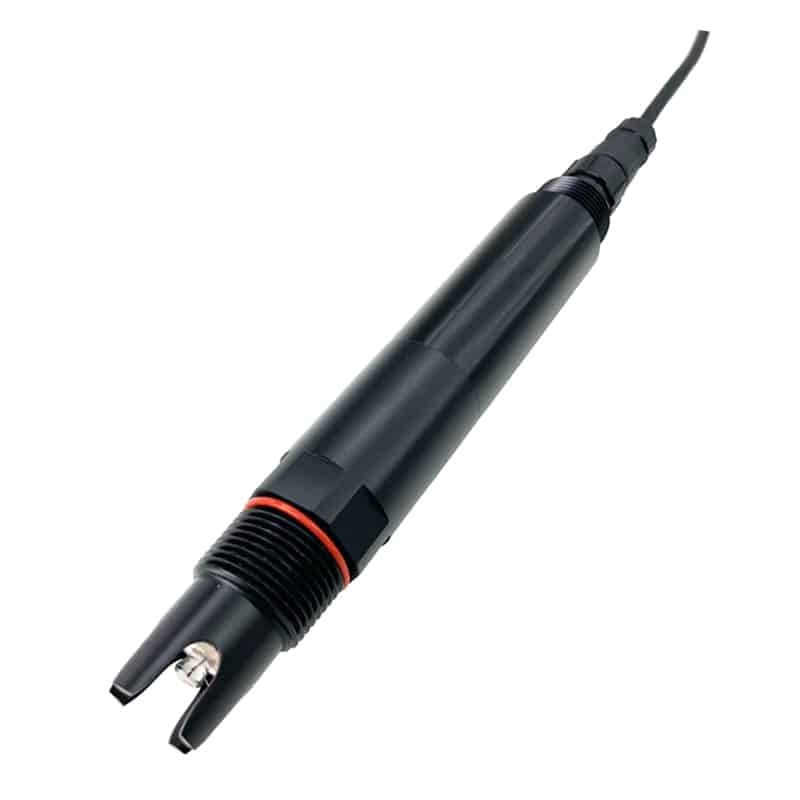An ORP sensor is a device used to measure the redox state of a solution. It evaluates the redox potential of a solution by detecting changes in the potential of redox reactions in the solution. This sensor is commonly used in water quality monitoring, industrial process control, and other chemical applications, providing users with a tool to monitor and control the redox state of a solution effectively.
How do you measure the redox potential in a solution?
ORP sensors measure the redox potential in a solution through a redox reaction at the electrode. Typically, ORP sensors have a layer of sensitive redox electrode material, such as silver/silver chloride, attached to the electrode surface. When the ORP sensor is placed in solution, a redox reaction in the solution occurs on the electrode surface, resulting in a change in the potential on the electrode surface. This change is detected by the sensor and converted into a corresponding electrical signal output. By measuring the change in this electrical signal, the ORP sensor can reflect the redox reaction in the solution accurately, thus providing information on the redox potential of the solution.
Components of ORP Sensors
ORP sensors typically consist of two main components:
Electrodes: One of the core components of an ORP sensor is the electrode. Electrodes are usually made of one or more materials that have good conductivity and chemical stability.
Connection circuitry: The connection circuitry is the key component that converts the signal from the electrode into a measurable output. It consists of electronic components such as amplifiers, filters, and converters that process the signal from the electrode and convert it to a corresponding electrical output. Connection circuitry also typically includes interfaces to a data acquisition system or control system to transmit measurements to a user or other device.


How does an ORP sensor convert measurements to an electrical output?
The process by which an ORP sensor converts a measurement into an electrical output typically involves the following steps:
- Signal detection: The electrode of the ORP sensor, when placed in solution, senses the redox reaction in the solution and produces a corresponding change in potential. The sensor’s circuitry detects this potential change.
- Signal amplification: The potential change detected is usually very small and needs to be amplified by an amplifier connected to the circuit to obtain a measurable signal.
- Signal processing: The amplified signal may contain some noise or interference, so it needs to be filtered and denoised by filters in the connection circuit to ensure that the output signal is stable and accurate.
- Signal conversion: The processed signal is converted to digital or analog form, usually through an analog-to-digital converter (ADC), for output to a data acquisition system or control system.
- Output interface: The final electrical output is transmitted through the sensor’s output interface to the user or other device for further processing, recording or control.
ORP sensor applications
Water quality monitoring:
- Measuring the redox state of water: ORP sensors can accurately measure the redox state of water, i.e. the balance between oxidizing and reducing agents present in the water. This is important for assessing water chemistry and environmental conditions, and can help determine whether a body of water is being affected by oxidation or reduction, and the types of contaminants that may be present in the water.
- Monitoring changes in water quality: The redox state of a water body is usually closely related to its levels of pollutants and organic matter. By monitoring the ORP value of the water, you can detect changes in water quality, such as the decomposition of organic matter, oxidizing substances, pollution, etc., to take timely measures to prevent the deterioration of water quality.
- Detecting pollutants: Some pollutants present in the water are usually oxidizing or reducing in nature, and the presence of these substances affects the ORP value of the water body.ORP sensors can be used to detect pollutants in the water, such as heavy metal ions, chlorides, nitrites, etc., to realize the rapid monitoring and assessment of water quality.
In summary, ORP sensors can provide critical redox status information in water quality monitoring, helping to assess the chemical nature of water bodies and the extent of pollution, thus providing important support for protecting the environment and maintaining water health.

The KPR Online ORP Sensor Probe is suitable for environmental water quality monitoring, acid/alkali/salt solutions, chemical reaction processes and industrial processes.
Industrial applications:
- Chemical production: In chemical production, ORP sensors are commonly used to monitor the redox status of the reaction process to ensure the stability and control of the process. It can help to monitor the level of oxidizing or reducing substances in the reaction solution in real time, thus guiding the production operation to ensure product quality and production efficiency.
- Metal processing: In metal processing, the ORP sensor can be used to monitor the oxidized state of the metal surface, as well as corrosion, discoloration and other issues. It can help to monitor the oxidizing substance content in the process fluid in real time, thus guiding the metal processing operation, prolonging the service life of the equipment and improving product quality.
- Wastewater treatment: In wastewater treatment, ORP sensor can be used to monitor the content of oxidizing or reducing substances in wastewater, to guide wastewater treatment operations and ensure that wastewater meets environmental standards. It can help realize the efficient treatment of wastewater and resource recycling, and reduce the pollution of the environment.
Advantages of ORP sensors
- Fast response: ORP sensor can quickly respond to changes in the redox state of the water.
- Intuitive and accurate: ORP value directly reflects the intensity of redox reactions in water.
- No reagent: Compared with some sensors that require the addition of reagents or standard solutions, ORP sensors do not require additional reagents, easy to operate, and low cost.
- Wide range of applications: ORP sensors are suitable for a variety of water quality monitoring scenarios, including water treatment, sewage treatment, industrial process control and other fields, with strong versatility.
- Stable and reliable: ORP sensors are designed to be stable and reliable, with good durability and anti-interference ability, able to work normally under complex environmental conditions.
- Real-time monitoring: ORP sensors can monitor the changes in the redox state of the water in real time, to help users find water quality problems on time and take appropriate measures to regulate and deal with them.
- No pollution: ORP sensors do not need to contact the water samples, to avoid secondary pollution of water quality, to maintain the originality of water samples.
ORP sensor challenges
Some of the challenges that may be encountered when using ORP sensors include:
- Environmental sensitivity: ORP sensors are sensitive to environmental conditions, including temperature, humidity, pH, etc. These factors may affect the accuracy and stability of the sensor.
- Electrode contamination: The electrodes of the sensor are susceptible to contamination, e.g., sediment, organic matter or air bubbles in the water may adhere to the electrode surface, affecting the sensor’s measurement accuracy.
- Maintenance requirements: ORP sensors need to be cleaned and calibrated regularly to keep their performance stable. This requires additional labor and time costs and can affect the continuity and efficiency of the production process.
- Electrode aging: The sensor’s electrodes age over time, resulting in inaccurate measurements. Electrodes need to be replaced periodically to ensure sensor performance and accuracy.
- Electrode spacing issues: Some ORP sensors require periodic adjustments to the electrode spacing to maintain their measurement accuracy, which requires specialized operating skills and equipment.
- Electromagnetic interference: Sensors can be affected by electromagnetic interference, especially in industrial environments where there is a large amount of electrical equipment and signal interference that can affect sensor performance.
- Changes in solution composition: Changes in the composition of the solution may affect the ORP sensor’s measurement results, especially changes in the amount of oxidizing or reducing substances present in the solution.
Summary
ORP sensor plays an indispensable role in water quality monitoring. By monitoring the redox status of water in real time, it can help us regulate water quality in time and prevent water quality problems. Whether in industrial production or daily life, ORP sensor is an important tool to ensure the safety of water quality, to create a clean and safe living environment.
Apure provides you with one-stop water quality monitoring solutions, including not only ORP sensors, but also a wide range of water quality parameters monitoring instruments, covering PH value, conductivity, dissolved oxygen, residual chlorine and so on, so that your water quality monitoring is more comprehensive and more reliable. In addition, we also provide liquid level and temperature monitoring instruments, as well as flow measurement instruments, to help you fully grasp the status of the water body, to ensure smooth production operations. Choose Apure to make water quality monitoring easier and more reliable.
